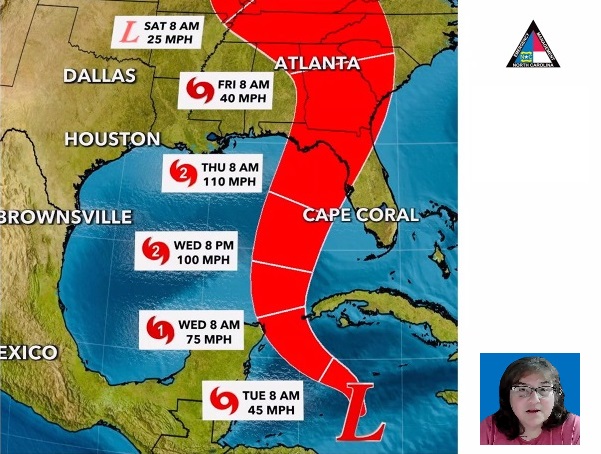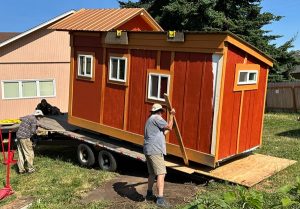North Carolina CERTs support 211 to connect family members
10 min read
Presenter: North Carolina’s CERT (Community Emergency Response Team) program manager describes how 211 connected loved ones in the aftermath of Hurricane Helene. In a FEMA Region 10 Zoom meeting Nov. 14:
Samantha Royster (NC CERT program manager): I can tell you as working in emergency management, working in the state EOC, I can tell you that we all feel it every time we hear that there’s been a fatality and it hits us all really hard when that happens.
[00:00:25] And for us to try to wrap our minds around the fact that there were, as we know today, 102, that’s just in North Carolina. This storm affected Georgia and Florida and South Carolina as well, but just in North Carolina we’ve lost 102 souls and it’s been really hard for all of us to deal with as well besides the people who live there and are going through it.
[00:00:50] So I just wanted to give you a little background as far as what the storm was like the storm did hit right there at the end of September, and of course, we were activated at the State Emergency Operations Center a day or two ahead of time. We were watching it for a week or more before, but as far as us actually being in the EOC and working, we pretty much started a day or two before it would hit North Carolina.
[00:01:15] And when we go to a full activation, that consists of 24-hour operations. So most of us worked from seven in the morning until seven at night during that activation. And then we have fewer people working the overnight shift, although we were still pretty well staffed during that time overnight because there was so much that was happening in the first few days.
[00:01:40] So we first got the request for CERT volunteers to help a couple of days after. So as you all know, working in emergency management, we don’t send people out in the height of the storm, even, you know, ambulances don’t go out if it’s more than tropical storm-force winds because it’s just not safe for the responders to go out. And the same goes for CERT volunteers.
[00:02:06] So we have a service in North Carolina that is a phone number, 211, that you can call. It’s usually activated during an emergency situation like this. So let’s say that you need meals, or you’ve run out of water and you can’t get water from your well, or for whatever reason you’re not connected to water, or even sometimes it’s if you just can’t afford to pay your rent, you can call 211 and they can find resources to help you with that. There’s also a number you can call if you are outside the state of North Carolina to help.
[00:02:41] So many 911 centers were affected by the storm. There were cases where even fire departments out in western North Carolina, there was one that was flooded and the firefighters had to cut a hole in the roof of the fire station to escape from the fire station because it flooded so rapidly they didn’t have a chance to get out.
[00:03:01] And there’s no power. We had well over a million people without power at the height of the storm. There’s obviously no internet, no telephones, no cell service. So there’s no communication out there and that was really difficult for everybody. Because communications, I mean, comms is like the number one thing, right, somebody said, what, ‘No comms, no battle,’ or something like that.
[00:03:27] We were using the 211 system as a means that, say you lived elsewhere in North Carolina and you had a loved one in the western part of the state and you had not been able to make contact with them, you could call 211 and request a welfare check or just file a missing persons report, like, ‘Hey, my sister lives in Asheville. I haven’t heard from her in two days. I don’t know if she’s okay. I can’t get in touch with her. Here’s her home address. Can you please go check on her?’
[00:03:57] And so the 211 would get that information out to the appropriate county and they could send people out to check on specific individuals that people were asking about. Although so many roads were washed out that there were places that you simply couldn’t drive to that you could a week before.
[00:04:18] So they were bringing in ATVs. We had supplies being brought in by mule trains. We had mules bringing supplies in, and in some cases, even if you had the person’s street address, that street might not be there anymore. So we were doing a lot when you take the street address down, it integrates with Google Maps, so we could get a latitude and longitude to find where that house should have been.
[00:04:44] And the 211 calls. After several days, after people made their calls, we would want to give them a call back to say, ‘Hey, have you located your sister in Asheville that you haven’t heard from.’ And the best situation would be, ‘Oh, yes, we found her. She’s fine. Everything’s good.’ That’s always a happy ending. And we love that. We close out the ticket and move on.
[00:05:05] Sometimes they would tell us, ‘Yes, we found them in there, deceased.’ And that was always difficult to hear. And in the very early days, what we heard most often was, ‘No, I still haven’t heard, I have no idea if my loved one is dead or alive, I don’t even know.’
[00:05:21] And so then we would escalate that up to the Search and Rescue dashboard. So we had well over 300 CERT volunteers who were making those phone calls back to people who had called in, looking for their loved ones. They made over 6,000 phone calls in about 10 days and logged about 3,700 volunteer hours making those phone calls.
[00:05:46] And for me, what I think really resonates about having them do that task is that every single person who made a phone call because they were concerned about a loved one, they got a personal phone call back from like a real human being and not just you know some call center somewhere. And these are all people who also live in North Carolina and were aware of the situation.
[00:06:11] And I think it was very impactful, you know, to have those individuals making those calls. I heard a lot of good things about it from both ends from the people who did it, and I talked to a couple of folks and I’m called a sympathetic crier. Like if you start crying, I’m going to cry too. And I try really hard to control that.
[00:06:35] But I mean I had one phone call where I was talking to a woman who hadn’t heard from her daughter in four days and she could hardly talk because she was choked up and crying and said I just need to know if my daughter’s okay and oh, it makes me want to cry. And I mean it’s, it was, the whole thing was just so emotional. But I was very proud of the work that our CERT volunteers did in making those phone calls.
[00:06:58] Other ways that we’ve been using CERT volunteers: We brought in several volunteers to the state emergency operations center in Raleigh who live in the general Raleigh area. We have a front desk there where we normally have a receptionist sitting on normal blue-sky days. Well, she was pulled off to do other stuff when we’re activated.
[00:07:18] So we brought in CERT volunteers to staff that desk and they were there 12 hours a day for I think three weeks that we staffed that and they were all volunteers who sat out there at the front desk. They were welcoming people, made sure everybody signed in, help people find where they’re supposed to go, all that kind of good stuff and they were just a warm welcoming face for them coming into the state EOC.
[00:07:42] I met Patrick because he joined our search and rescue team which was the first SAR team in North Carolina to require CERT training to be a member of the SAR team and that was sort of Patrick’s indoctrination to CERT. And I know that you were just itching to get out in the mud in the muck and actually go and do search and rescue out in the mountains.
[00:08:06] I was just wondering, like: Were you frustrated that you couldn’t do that? Were you satisfied with what you were able to do at the state EOC? How are you feeling about your participation for this storm?
[00:08:19] Patrick: Yeah, great question. Initially, absolutely frustrated because that’s my passion and that’s what I love to go do. But after a couple days, maybe only two days being at the EOC, I saw that instead of me being on the ground finding one or two people, I was able to impact the lives of hundreds, if not thousands of individuals through some of these different activities and see us actually make an impact on a whole town or a community.
[00:08:47] So that was extremely rewarding and definitely put things in a different perspective for me. So as much as I really wanted to get muddy and dirty, I was making a bigger impact by being a part of this well-oiled machine that was trying to help the community in a greater capacity.
[00:09:07] Presenter: Local businesses also supported the community.
[00:09:11] Kimberly Austin (Fuquay-Varina CERT program): My name is Kimmy Austin. I am program manager for our Fuquay-Varina CERT here in North Carolina, which is our newest CERT program in the state. I also have the opportunity to work at the state emergency response team with the Business Emergency Operations Center. What that entails is there are business partners like Walmart, Home Depot, Lowe’s, all of these big box companies all the way down to our small businesses that want to and are ready to help during an emergency of any kind.
[00:09:54] And part of what we do in this office is we build those relationships on blue-sky days so that way when we have things like this, we are their touch point. Or if we are looking for something. So we can start with something as easy as bottled water. We may have a contact at Coca-Cola and they’ll be like, ‘Yes, we’re going to bottle and bring 18 tractor trailers of water wherever you need it.’
[00:10:30] Samantha Royster (NC CERT program manager): And I got to say, I appreciate both of you guys so, so much and there are others too, but Kimmy and Patrick have been instrumental in helping us and so very grateful to them. And just for everybody’s knowledge here in North Carolina for search and rescue in this storm, particularly, the initial response was we needed with water rescue teams and here in North Carolina. Those are primarily fire departments and they’re professional firefighters, and like Patrick and I, we do wilderness search and rescue and it’s not exactly what was called for in this situation. They needed those swift water teams.
[00:11:10] And then we brought in urban search and rescue and they can search collapse structures and things like that, where Patrick and I and our team, we do, you know, a hiker who is overdue and hasn’t come back, or a child who’s wandered off or somebody with dementia who’s wandered off. And that’s the kind of search and rescue training we generally do. So, but yeah, y ‘all have been amazing.
[00:11:33] Presenter: She was asked whether the CERTs had previous training for the 211 calls.
[00:11:39] Samantha Royster (NC CERT Program Manager): Yeah, no. That was just-in-time training and one of the things that was really cool about that is that people could do it from their own homes. So we got Excel spreadsheets from the 211 people and it had all the information: Who was the caller, who were they looking for, what’s their address, when’s the last time they were seen.
[00:11:59] All that kind of information was in the Excel spreadsheet and then the volunteers would call and so to make sure that people weren’t getting multiple phone calls, I would get and so this is literally the first spreadsheet I got, had 6,000 lines of data. And so I split that up and I sent each person 50. I didn’t want to overwhelm people. I mean, 50 phone calls seems like a lot, but we had a lot of volunteers working as well. So I would send each individual person 50 lines to call and then I kept track kind of on a master list of who was doing which calls.
[00:12:35] And then they when they would make the phone call they had a website to pull up so they were inputting data as they were talking to the person so they would say, ‘Hi I’m Samantha, with such and such CERT program. I understand you’re looking for your sister Susie,’ and then go through the website and answer the questions and plug in the answers. Even if the person had been found alive or deceased, we wanted them to close that ticket out.
[00:13:03] If the person was still not found, then there were more questions to ask and then they would just hit submit at the end of that and it automatically got escalated to our Search and Rescue dashboard. Yeah, so totally on-the-job, just-in-time training.
[00:13:21] As of this week, CERT volunteers in North Carolina have put in close to 3,900 hours. And as of July 1 of this past year, the IRS values a volunteer hour at $33.80. So that’s well over $125,000 worth of volunteer time so if y ‘all, but yeah, so 3,900 hours in seven weeks.
[00:13:45] And we know how many people are out there on the ground in Western North Carolina, trying to help people. And then we see just terrible news stories that are not accurate: ‘FEMA has forgotten us. Nobody’s here.’ And it’s just, it’s really, it’s really sad and it’s very disheartening. And I’ve never seen that level of disinformation on any other storm. I don’t know why that is, but it’s been very disheartening.
[00:14:14] Presenter: North Carolina’s CERTs help connect families in the aftermath of flooding from Hurricane Helene. CERTs are also training locally to support Lane County residents in the next disaster. To learn more, see the Eugene Springfield CERTs website.




